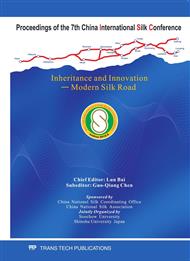p.30
p.36
p.41
p.46
p.51
p.56
p.61
p.67
p.72
Full Length cDNA Cloning and Expression Characteristics of Ace Gene from Wild Silkworm, Bombyx mandarina
Abstract:
Acetylcholinesterase (AChE), which contains two subfamilies, ace1 and ace2 in insects, was identified to be the target of organophosphorous and carbamate insecticides. To research the sequences and tissues expressions of two aces, full length cDNAs encoding two ace genes were cloned, designated as Bmm-ace1 and Bmm-ace2 from larvae of the Bombyx mandarina. The amino acid sequence of Bmm-ace1 shared 99.71 % homology with its homolog, Bm-ace1, in silkworm, Bombyx mori, with two mutations (G664S and S307P), and the amino acid sequence of Bmm-ace2 shared 99.37 % homology with Bm-ace2, in B. mori , with four mutations (M18I, N233S, I310V and G621S). Tissue expression analysis showed that ace1 gene expressed only in the brains and fat bodies of B. mandarina, while ace2 genes expressed in all the tissues tested. ace1 and ace2 expressed highly in brains and fat bodies. The present results are significant to the study of resistance evolution of Lepidorptera as well as the understanding of the mechanism of pesticide resistance of insects.
Info:
Periodical:
Pages:
51-55
Citation:
Online since:
January 2011
Authors:
Keywords:
Price:
Сopyright:
© 2011 Trans Tech Publications Ltd. All Rights Reserved
Share:
Citation:


